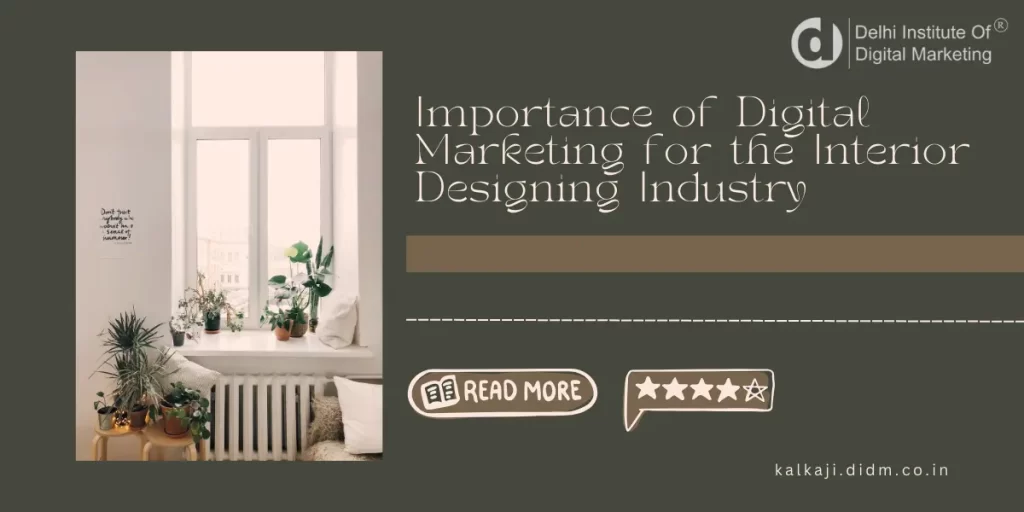
The interior designing industry has always been a creative and competitive field. Rooted in aesthetics, personal connections, and trust, this industry thrives on visibility and reputation. In today’s digital age, the way designers showcase their skills and connect with potential clients has transformed dramatically. Digital marketing has emerged as an indispensable tool for interior designers, helping them expand their reach and build lasting relationships with their target audience. Let’s explore why digital marketing is crucial for the interior designing industry.
Wider Reach and Visibility
Traditional marketing methods, like word-of-mouth or print media, often limit reach to local audiences. Digital marketing, however, breaks these barriers with its global reach. Platforms like Facebook, Instagram, and Pinterest empower designers to showcase their portfolios to a worldwide audience. Even for designers targeting local markets, maintaining an online presence ensures that potential clients in their city or region can easily find them when searching for services.
Additionally, social media ads and search engine optimization (SEO) allow designers to target specific demographics. This ensures that their work is seen by people genuinely interested in interior design and more likely to become clients.
Cost-Effective Marketing
Compared to traditional advertising, digital marketing offers a cost-effective alternative. Running ads on platforms like Google or social media is often more affordable than printing brochures or airing television commercials. This affordability allows small to medium-sized design firms to compete with larger organizations by using digital tools strategically and allocating resources more efficiently.
Visual Appeal and Storytelling
As a visually driven industry, interior design finds a perfect ally in digital platforms that enable storytelling through images, videos, and virtual tours. Instagram and Pinterest are particularly powerful for sharing projects, mood boards, and before-and-after transformations. A well-curated feed not only attracts followers but also builds credibility.
Video content is another game-changer. Platforms like YouTube and Instagram Reels allow designers to share tips, behind-the-scenes footage, and client testimonials. These storytelling techniques create an emotional connection with potential clients, making the brand more relatable and trustworthy.
Building Credibility with Reviews and Testimonials
Online reviews and testimonials play a critical role in clients’ decision-making processes. Platforms like Google My Business and Houzz provide spaces for satisfied clients to leave feedback, which can significantly influence potential customers. Positive reviews build credibility and establish trust, while actively engaging with reviews—both positive and negative—demonstrates professionalism and a commitment to customer satisfaction.
Personalized Customer Engagement
Digital marketing tools enable designers to interact with their audience in a personalized manner. Email campaigns can be customized to share updates about ongoing projects, design trends, or helpful tips. Social media interactions—likes, comments, and direct messages—foster a sense of community and engagement. Prompt responses to inquiries or feedback showcase a dedication to customer satisfaction, strengthening relationships with potential clients.
Data-Driven Decision Making
One of the most significant advantages of digital marketing is access to real-time analytics. Tools like Google Analytics, Facebook Insights, and Instagram Analytics offer insights into campaign performance. This data helps designers understand which content resonates with their audience, allowing for more informed decisions about future strategies.
For example, if an Instagram post showcasing a minimalist living room design garners high engagement, it indicates a preference among the audience. Designers can then create similar content to drive further interaction.
Showcasing Expertise through Content
Content marketing is a powerful way to establish authority in the interior design industry. Blogs, eBooks, and video tutorials on topics like “Top 10 Small Space Design Hacks” or “How to Choose the Perfect Color Palette” provide value to the audience while positioning the designer as an expert. This type of content builds trust and attracts clients seeking knowledgeable professionals.
Adapting to Changing Client Behavior
Today’s clients are tech-savvy and rely heavily on online research before making decisions. Most start their search for an interior designer by browsing online portfolios, reading reviews, or exploring social media pages. A weak or nonexistent digital presence risks losing potential clients to competitors who have embraced digital marketing.
E-Commerce Opportunities
The rise of e-commerce has created new opportunities for interior designers. Designers can sell customized furniture, home decor items, or design consultation packages online. Digital marketing plays a crucial role in promoting these products or services, reaching audiences that traditional methods might not.
Conclusion
The interior designing industry is evolving, and digital marketing is no longer optional—it is essential. By leveraging the power of social media, SEO, content marketing, and data analytics, designers can enhance their visibility and build meaningful connections with clients. Digital marketing allows interior designers to showcase their creativity, expertise, and unique style to a broader audience, ensuring sustained growth in an increasingly competitive market.
For interior designers looking to stand out and grow their business, embracing digital marketing strategies is the key to unlocking new opportunities and achieving long-term success.

